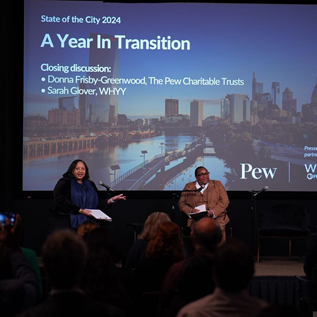Progress on Court Reforms
Implementation of Recommendations from Pew Commission on Children in Foster Care
QUICK SUMMARY
The release of the court recommendations of the Pew Commission on Children in Foster Care in 2004 focused greater attention on the need to enhance dependency court performance to achieve improved outcomes for children and youth in foster care and their families As part of a first of its kind national judicial summit in 2005, states developed action plans to strengthen dependency court performance in the four critical areas identified by the Pew Commission: accountability, collaboration with child welfare agencies, judicial leadership, and constituent voice The Deficit Reduction Act of 2005 provided $100 million in court improvement funds to support judicial reforms across the countryIn this review, Kids Are Waiting both examines the progress that states have made since the 2005 summit in strengthening their dependency courts and improving outcomes for children, youth, and families, and makes recommendations for continued improvements.
The release of the court recommendations of the Pew Commission on Children in Foster Care in 2004 focused greater attention on the need to enhance dependency court performance to achieve improved outcomes for children and youth in foster care and their families. As part of a first of its kind national judicial summit in 2005, states developed action plans to strengthen dependency court performance in the four critical areas identified by the Pew Commission: accountability, collaboration with child welfare agencies, judicial leadership, and constituent voice. The Deficit Reduction Act of 2005 provided $100 million in court improvement funds to support judicial reforms across the country. In this review, Kids Are Waiting both examines the progress that states have made since the 2005 summit in strengthening their dependency courts and improving outcomes for children, youth, and families, and makes recommendations for continued improvements.
Today, more than 510,000 children are in foster care.i Although many children removed from their homes because of suspected abuse or neglect will return safely after only a few months away from their families, tens of thousands will remain in limbo in the foster care system for years. Some of these children will never be placed in a safe, permanent family through adoption or guardianship; instead, they will exit foster care by “aging out” when they reach the age at which they become ineligible for support (generally age 18) without the safety net or support of a family.
No child enters or leaves foster care except by approval of the court. Courts across the country play a crucial role in determining the path that a child who has been abused or neglected will take - whether it is returning home, joining a new family through adoption, being placed with relatives, or remaining in foster care until they “age out.” Yet, despite this vitally important role, the Pew Commission on Children in Foster Care found that “dependency courts are often undervalued entities within the judicial system. The public is largely unaware of the depth of the court's responsibility in cases of abuse and neglect and has little information on its effectiveness in protecting children and promoting their well being. Within the larger state court system, dependency courts compete for resources with higher-profile criminal and civil courts.” ii
Until 2006, dependency courts were subject to only limited formal accountability for ensuring that children in foster care moved through the child welfare system and into safe, permanent families as quickly as possible. Judges, each often charged with overseeing up to a thousand cases per year, lacked the resources to maintain current information on the progress made on behalf of the children and families on their dockets. In many instances, judges faced large caseloads, a lack of data tracking systems, and time constraints. Dependency court leaders agreed that improvements were needed in several key areas: greater court accountability, stronger collaboration between the courts and child serving agencies and organizations, adequate legal representation of the children and families who came before them, and judicial leadership to improve court performance.
Over the past several years, courts have made significant improvements in addressing the needs of children and families served by the child welfare system. From improved case tracking and enhanced management information systems to designating judicially-led commissions to identify and address issues affecting children and families, courts have made substantial progress in improving outcomes for vulnerable children and families. The Kids Are Waiting campaign applauds state courts -- including judges, legal professionals and court personnel -- for these efforts and encourages them to continue the significant work that they have undertaken to achieve the best outcomes for children and families in their jurisdictions.
Since the Pew Commission on Children in Foster Care issued its report, and as a direct result of the federal Court Improvement Grants made possible by the DRA, states have made significant progress in strengthening court proceedings in child abuse and neglect cases. Map 2 shows the areas on which states have focused in implementing action plans to improve the lives of children and their families. State courts have enhanced accountability primarily through improving data collection and/or management information systems. Many states have taken this work one step further and coordinated court child and family data with that of the child welfare agency. Coordination of data collection and review has the potential to improve both court and agency case tracking, and decrease the time that children spend in foster care. Some states have evaluated and made efforts to decrease family court judges' workloads. Across the nation, family court judges have assumed leadership roles in expediting permanency for children and youth in
foster care. States have implemented model courts and initiated pilot programs. States also have worked to improve the quality of legal representation for children, youth and parents. Courts have employed a range of tactics, from trainings for judicial officers to studies on how best to ensure that the voices of children and families are heard in dependency proceedings.
Recommendations
Across the country, state dependency courts have implemented numerous reforms – those included in their 2005 action plans as well as new efforts. However, there is still more to be done in the areas of accountability, collaboration, and strengthening of the voices of children, youth and families in court proceedings.
- State dependency courts can promote better outcomes for children and youth through continuing efforts to strengthen case tracking mechanisms, data collection, and data sharing between courts and child welfare agencies. Despite good progress by dedicated court personnel nationwide, more improvements are still needed related to the tracking of child welfare cases. By increasing accountability through better monitoring and movement of cases through the judicial process in a timely way, more children and youth will end up in the safe, permanent families that they need and deserve, rather than waiting in uncertainty, adrift in the foster care system.
- Nearly half of the states are currently exchanging data or collaborating with child welfare agencies; the remaining states could improve child and family outcomes by developing similar initiatives. Efforts need to continue to strengthen collaborative relationships between the courts and child welfare agencies and other child and family serving organizations. Many states have focused attention on collaboration, with extremely promising results.
- In addition, more should be done to ensure that the voices of children, youth, and families are heard in their court proceedings. The great majority of states (96 percent) initiated some type of activity to enhance constituent voice, but most states reported training Guardians Ad Litem and Court Appointed Special Advocates rather than implementing practices to ensure the presence of children, youth and families in the court room whenever possible. A key recommendation is that all states initiate activities that actively bring children, youth, and their families into the court process. Some state courts already have mandated that all yout









